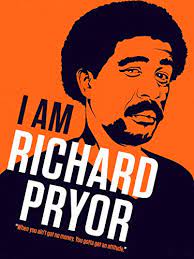
I AM RICHARD PRYOR
US, 2019, 93 minutes, Colour.
Directed by Jesse James Miller.
This portrait of Richard Pryor is one of a series of television portraits of celebrities, especially of film, television and stage. They have been produced by Derek Murray, beginning with Bruce Lee in 2012. Other portraits include Steve McQueen, Paul Walker, Burt Reynolds.
The format is to provide a profile, with some warts and all, of the celebrity. By the end, the audience knows the details of the life of the star, difficulties in upbringing, the motivation for a career, changes in development of career, success, personal failures, significance in American cultural history of the 20th century.
International audiences may be familiar with Richard Pryor from his appearance in movies, especially in such films as Silver Streak, Stir Crazy and his collaborations with Gene Wilder. Americans may be familiar more familiar with his historical television appearances during the 1960s and 70s, later, his range of special television programs. Richard Pryor was a distinctive presence.
The screenplay gives a lot of attention to Richard Pryor’s origins in Peoria, Illinois, born in 1940, growing up in a brothel managed by his grandmother, his mother being one of the prostitutes, his father being a pimp. He was placed in the custody of his grandmother while growing up and had a devotion to her.
Early in his career, influenced by Bill Cosby and his appearances on television, during his 20s, Richard Pryor made quite an impact, imitating Cosby, going on many television shows, including Ed Sullivan, which catered for a wide audience. He also began to make film appearances in the 1970s, including a serious appearance with Diana Ross in Lady Sings the Blues, about Billie Holiday, and later the films with Gene Wilder into the 1980s, working with Sidney Poitier. However, he also went to Las Vegas, walked out, took a break, seemingly having a significant change of mind and heart in his decisions about performing, moving towards the black audience, revealing the background of his life, the themes, speaking to the minds and hearts of this audience. This was confirmed by support from Lily Tomlin, inviting Richard Pryor onto her program and her performing with him in a sketch that offended some of the white executives. Lily Tomlin is one of those talking heads throughout the film, significant in admiration for Pryor.
Also present is his former wife, his fourth, Jennifer Lee Pryor. She is particularly frank about her love for Pryor, the difficulties, trying to care for him, it being too much, her leaving, but with the development of his MS, coming back to care for him. At the end, she is seen pouring his ashes into the ocean in Hawaii, at a haven that they use to come to.
There are many black voices, comedians Tiffany Haddix and Mike Epps, director, Michael Shultz, and a number of directors and historians. There is quite some admiration for Pryor, an emphasis on his ability to communicate with the black audiences, articulating black issues – with the rough and tumble and language of the stand-up comedians of the time.
The film is also frank in its acknowledgement of Pryor’s lifestyle, his many relationships with women, three wives and divorces, the marriage to Jennifer Lee, the drugtaking of the period, the range of drugs, his free-basing, the accident with fire (suggesting a death wish), his continued relapsing.
A portrait of flawed genius. An acknowledgement of his place in the American consciousness, especially of race issues.